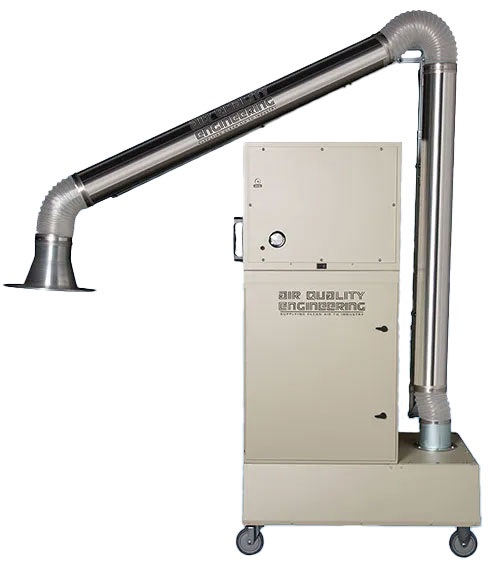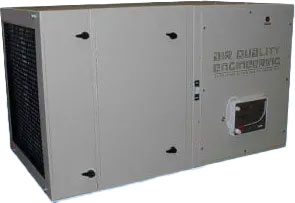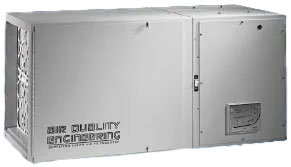Welding Fume Extractors: Portable, Overhead & Ambient
Units to remove welding smoke and fumes from the air
Air Quality Engineering manufactures cutting-edge welding fume extractors. We realize that for businesses to succeed in today’s environment, safety is paramount. As industry leaders, we understand that your operations also require the utmost precision and productivity. That’s why we’ve designed a comprehensive lineup of welding fume extractors tailored to meet the exacting standards of your industrial environment. Our collection features portable, ambient and overhead extractors, each engineered to improve the well-being of your workforce while maintaining optimal workflow efficiency. This includes popular wall mount units. As you continue your search for an air filtration solution, please contact us to speak to one of our technicians who will help guide you to the best air cleaner for your application.
Problem: New Appreciation of Health Hazards from Welding
Advances in welding technologies have been accompanied with a new appreciation of the health hazards associated with common welding processes such as SMAW (stick), FCAW (Flux core) and GMAW (MIG).

These hazards can present exposure concerns even when welding on common carbon steel. Recent research has identified problems with exposures to manganese, chromium, nickel and other potentially toxic metals in welding fume. OSHA has recently promulgated a new regulation focused on the carcinogen, hexavalent chromium (CrVI or Cr6+). These health hazards, along with the understandable reluctance on the part of welders to wearing a respirator under the welding hood, mean that better approaches to removing welding fumes from the welder’s breathing zone are required.
Click Here to Learn More about Compliance Requirements for Chromium (VI)

M66 Air Filtration Media System with 360 Degree Rotating Overhead Source Capture Arm

AQE4000 Reverse Pulse Jet Dust Collector with Twin Fume Extraction Arms
Solution: Practical Engineering Controls
Industrial fume extractors provide a wide range of options both in terms of air cleaning technology and welding safety equipment. We offer three industrial units that are suitable for welding fume extraction. Electrostatic air cleaners feature permanent collector cells which offer high filtration efficiency along with the advantages of eliminating ongoing filter replacement costs. Some applications are best served by conventional media filtration and we offer several options using this technology: inexpensive bag filters, extended service mini-pleated filters and, when required, HEPA filters.
When long maintenance intervals at high fume loading are the driving factors, our reverse pulse cartridge systems are the answer in these high production applications. Each of these three air cleaning technologies (electrostatic, conventional media and cartridge) are available in portable, ambient (general background) or overhead ducted configurations. Portable fume extraction systems like the Porta Air™ are ideal for welders on the move. Ambient (sometimes referred to as general background) air cleaners work well for dispersed welding stations. Overhead ducted filtration systems provide the advantages of source capture while conserving expensive floor space. Also remember the importance of proper placement of the source capture arm to welding arc. This video shows you how effective our equipment is.
Cost of Our Welding Fume Extractors
The cost of our welding units varies depending on a number of factors. This includes which product model you need, how many and which optional features are added to each unit. All our units are made in the USA, which helps to keep prices low. For a specific quote on how much a specific welding unit costs, please call us at (888) 883-3273.
Please review our product information and work with our application professionals to identify the correct solution to meet your requirements in your welding or other industrial environment.
FAQs
Do welding fume extractors really work?
Yes, fume extractors work when the collector arm is properly placed near the work area. The air is filtered and returned to the shop area. When a shop is heated or cooled, they do not remove the conditioned area.
How do welding fume extractors work?
Fume extractors work by pulling weld fumes into the collector hood when properly placed near the work area. The air is filtered and returned to the shop area. When a shop is heated or cooled, they do not remove the conditioned area.
What is the flow rate for welding fume extraction?
Flow rates vary with size ranging from 1,100 – 3,000 CFM.
What applications do welding fume extractors work best for?
Fume extractors work for all applications. However, some applications may require a HEPA or a carbon filter.
Do you need a fume extractor for welding?
That varies with the amount of welding being performed and the location. It is the healthy choice for welding indoors.
How close should my fume extractor’s hood be to the welding arc?
There is not a specific distance or alignment requirement for the extractor hood. It should have the proper CFM to allow enough room, so it does not interfere with your work and the fumes are visibly pulled into the hood.
Why should I use a fume extractor instead of an ambient (overhead) air cleaner?
Fumes are removed faster, and more efficiently. A smaller unit can also be used.
Why should I use a fume extractor instead of wearing a respirator?
The fume extractor will filter the fumes out of the room where the respirator will not, and the fumes will still be present when the mask is removed.
How do excessive amounts of manganese affect a weld? Or a welder?
Excessive amounts of manganese in a weld can significantly strengthen the weld metal, but at the expense of its ductility, making the weld more brittle and susceptible to cracking, essentially making it too hard and less flexible; this is because manganese acts as a hardening agent in steel when present in large quantities.
In the welding industry, manganese is incorporated in consumables, such as rods and wires, for three types of welding processes: Shielded Metal Arc Welding or “Stick” Welding, Gas Metal Arc Welding or “MIG” and Flux Core Arc Welding. This can expose a welder to manganese during welding.
According to the Centers for Disease Control and Prevention (CDC), “A healthy person with normal liver and kidney function can excrete excess dietary manganese.” However, when this mineral is inhaled, it bypasses the body’s normal defense functions and can cause adverse health effects to the central nervous system.
Additional Welding Air Filtration References
- Manganese in Welding Fumes: The Adverse Health Effects & How to Reduce Them
- Risks Of Hexavalent Chromium Overexposure
- The Health Hazards of Manganese on Welders
- Positioning Of The Source Capture Hood During Welding
- Welding Hazards and Your Workplace
- Good Choices For Weld Fume Collection
- Overcome Weld Fume Collection Issues
- New Weld Fume Collection Arm


